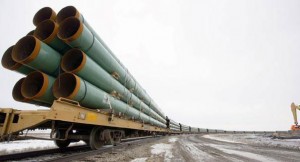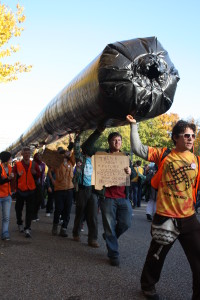We have much more to do and your continued support is needed now more than ever.
Keystone XL: Don’t Ignore Climate Change 400k Americans Tell Feds
 The U.S. State Department has received a second application from TransCanada to build the Keystone XL pipeline, or as I like to refer to it—the zombie pipeline. The Obama administration has already given the green light to the southern segment that stretches from Cushing, Oklahoma to Port Arthur, Texas. However, they still need a permit for the northern segment—which must involve oversight by the State Department since it crosses the Canadian border.
The U.S. State Department has received a second application from TransCanada to build the Keystone XL pipeline, or as I like to refer to it—the zombie pipeline. The Obama administration has already given the green light to the southern segment that stretches from Cushing, Oklahoma to Port Arthur, Texas. However, they still need a permit for the northern segment—which must involve oversight by the State Department since it crosses the Canadian border.
Over 440,000 people submitted comments to the State Department last month asking them to include the project’s impact on climate when assessing the new route. The climate impacts of a project this dirty should be included in what is called a supplement environmental impact statement (SEIS) that is required by the state department in a situation where a project has had major changes.
In KXL’s case, they have had to reroute the northern segment to avoid Nebraska’s Sandhills. Incredibly, last time TransCanada applied there was no assessment on potential climate impacts. Accordingto the Environmental Protection Agency (EPA) the Keystone XL pipeline has the potential to increase carbon pollution by 27 million metric tons of carbon dioxide, the equivalent of 6.2 million cars on the road for 50 years. Let’s do it right this time.

Speaking Out
Millions of people have been voicing their concerns about this project and what it means for future generations. The United States needs to weigh the climate impacts of energy projects before moving forward on them. We know climate change is happening now, and we cannot continue to ignore the impacts we are already enduring. Climate scientist, James Hansen, has warned that developing tar sands would be “game over for the climate.” The Obama Administration has made a commitment to mitigate climate change in his famous speech where he said, “this was the moment when … the rise of the oceans began to slow and our planet began to heal.” So what legacy do we want to leave for our kids?
The development of tar sands means investing in one of the dirtiest forms of energy on the planet. That is why millions of people have joined together in the fight against the Keystone XL pipeline–a project that would drive a massive expansion of habitat-destroying tar sands operations.





















